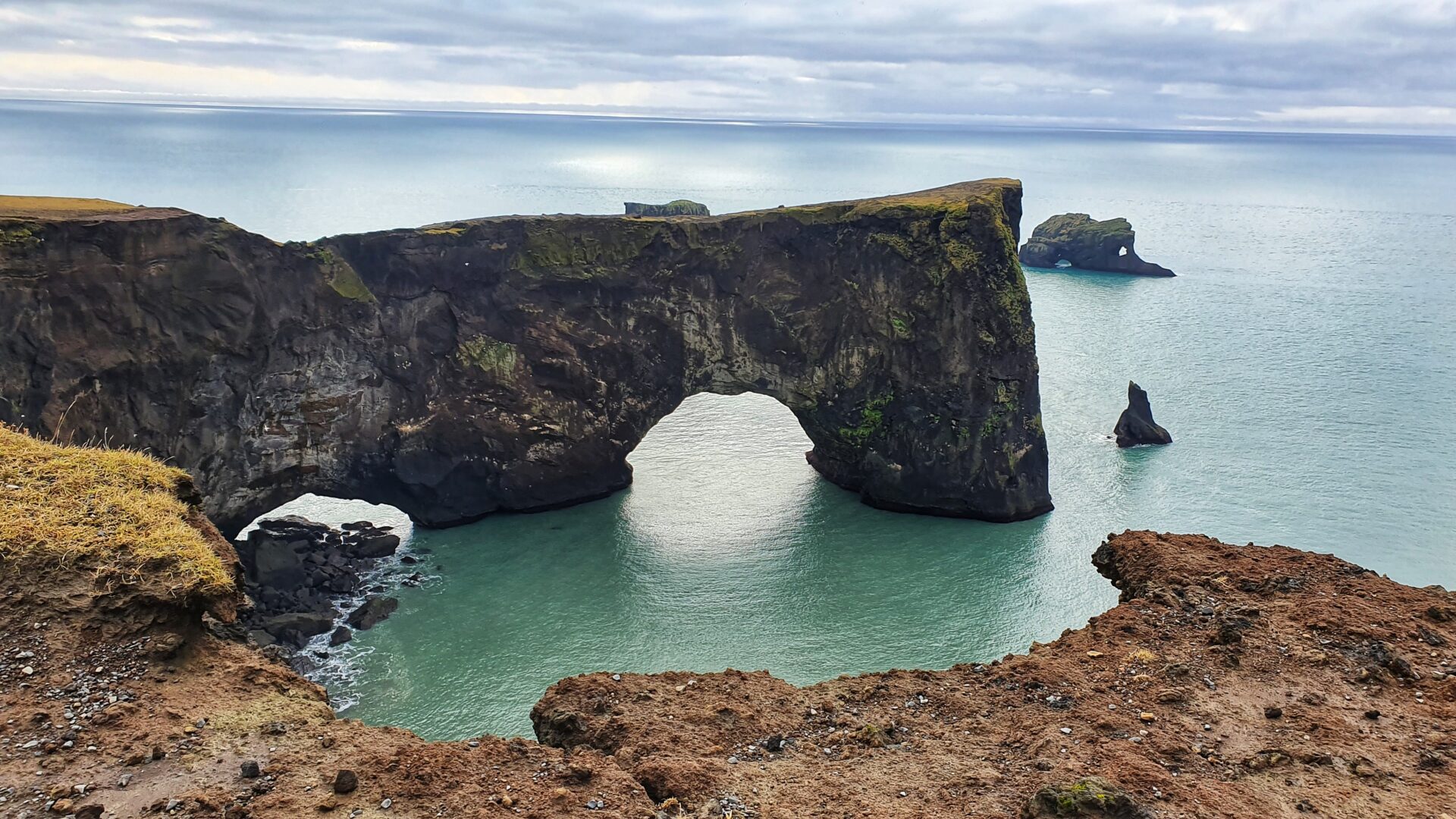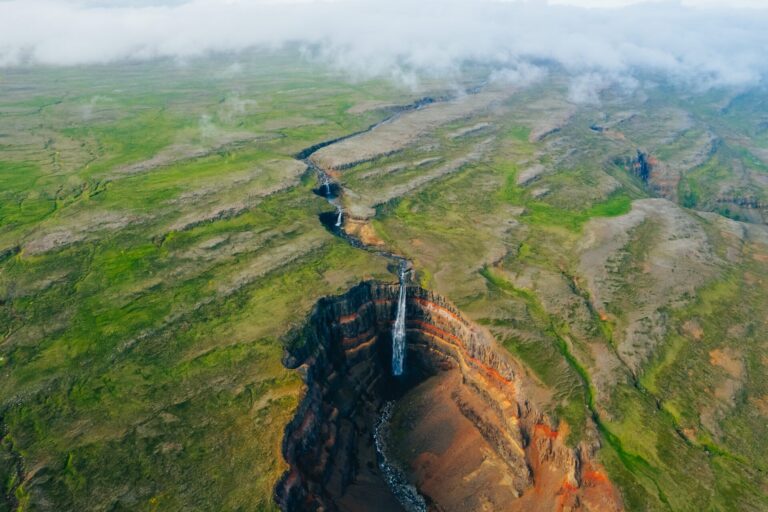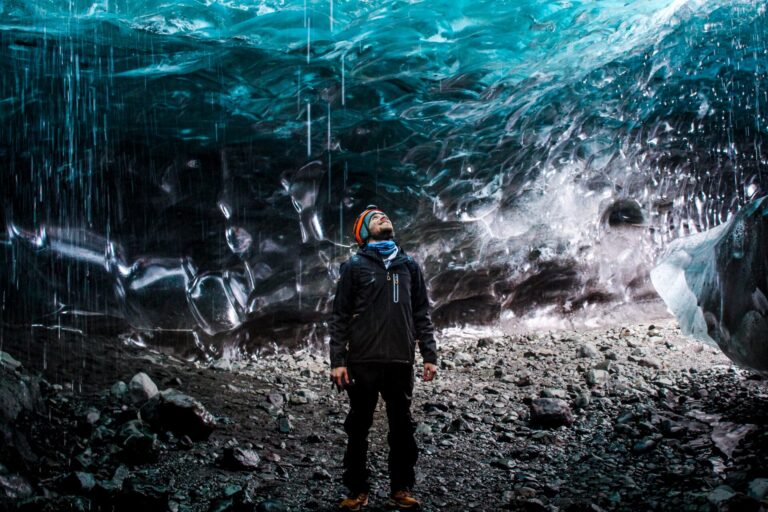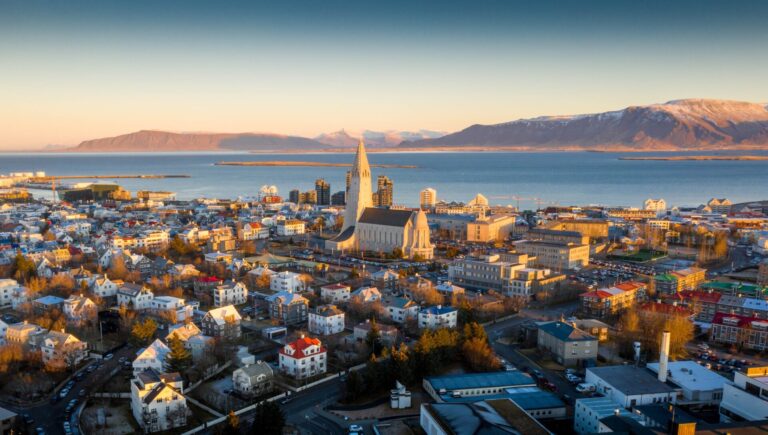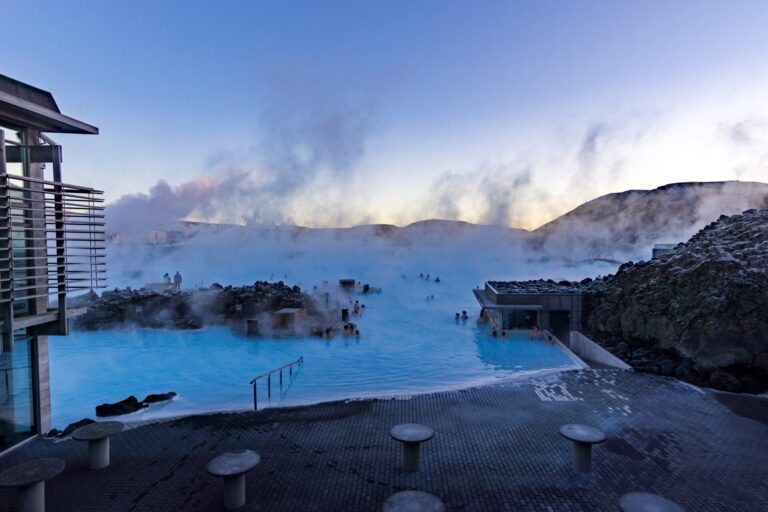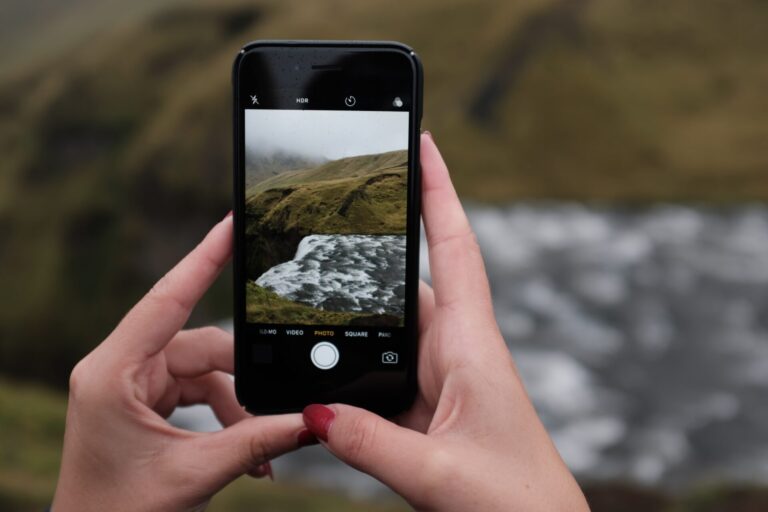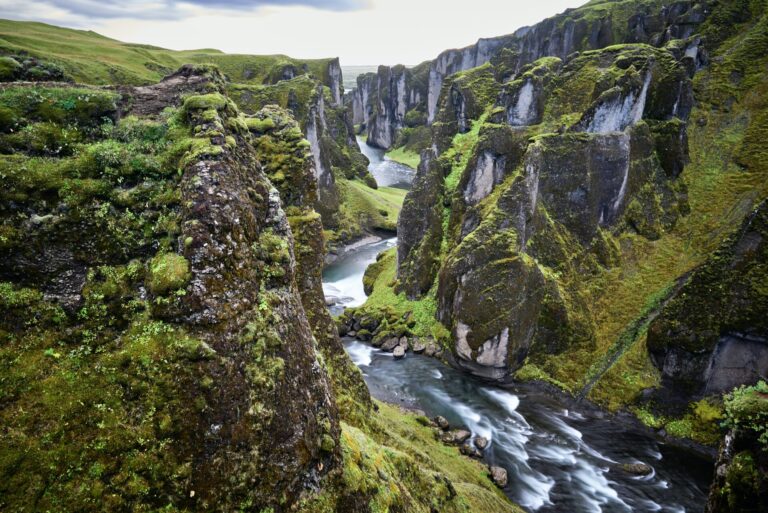A guide to Dyrholaey; the arch, the lighthouse, and the Viking history
Dyrholaey is a picturesque peninsula on the south coast of Iceland, which boasts a variety of natural and cultural attractions, including a prominent rock arch, a historic lighthouse, and glimpses into the area’s Viking history.
From the peninsula, visitors can take in breathtaking views of the Mýrdalsjökull glacier and Reynisdrangar sea stacks, making Dyrholaey the perfect destination for photography enthusiasts, wildlife watchers, and those interested in exploring the region’s rich history and culture.
Page Contents
About Dyrholaey
Dyrholaey is a unique place in Iceland with a rich history that dates back to Viking Age as the area was once home to several ancient Viking settlements and burial grounds. It is thought to have been inhabited for over a thousand years.
During the Viking Age, the village was important for fishing and a key center of trade and commerce in the region as the Vikings who lived there were skilled seafarers and traders. They used the natural rock arch at Dyrholaey as a navigational landmark when fishing.
In addition to its economic importance, Dyrholaey was also an important cultural and social center for the Vikings. The village was home to a number of chieftains and other influential figures, and it was a hub of cultural exchange and innovation. The Vikings who lived in the village were known for their craftsmanship, particularly in metalworking and shipbuilding, and their skills and innovations helped to shape the culture and society of the region.
Nowadays, Dyrholaey is still known for its black sand beach and natural rock arch, a rare and impressive geological formation (similar to the Durdle Door and the Etretat arches). The arch was formed over time by wave erosion, and it is now a popular spot for photography and sightseeing.
Next to the arch, Dyrholaey also has a historic lighthouse that was built in 1927 to help guide ships through the treacherous waters of the region, and it is still in operation today!
The lighthouse is located at the highest point of the peninsula and offers astonishing panoramic views of the surrounding landscape, which is why it is a popular spot for photography, sightseeing, and chasing sunsets.
In addition to its natural beauty and historical significance, it is also home to various birdlife, including puffins, which can be seen nesting on the cliffs from May to August.
Basic facts about Dyrholaey
The name “Dyrholaey” means “door hole island,” and it is thought to refer to the natural arch that serves as a “doorway” to the sea.
| Region | South coast of Iceland |
| Type | Natural rock arch |
| GPS coordinates | 63.429167, -19.056667 |
| Names | Dyrholaey, Door Hole Island |





How to pronounce Dyrholaey?
Dyrholaey is pronounced, “deer-hoo-lay.” The first part of the word, “dyr,” is pronounced like the English word “deer,” while the second part, “holaey,” is pronounced with a long “o” sound, as in “hoo.” The final “ey” sound is pronounced like the “ay” in “hay.”
Can you walk over the Dyrholaey arch?
Yes! In the early 20th century, a group of fishermen from the village of Vik decided to test the strength of the rock arch by driving a herd of sheep across it. The sheep were able to make it safely across the arch and back, and the fishermen declared the arch to be strong enough to support the weight of a human.
Inspired by this story, a young man named Sæmundur Þórarinsson decided to try crossing the arch himself. He made it safely across the arch and back, and his successful crossing of the arch became a local legend. In the years that followed, many other people attempted to cross the arch, and it became a popular tourist attraction.
Legends around the Dyrholaey arch
There is a legend about the rock arch at Dyrholaey that dates back to the Viking Age. According to the legend, the arch was once home to a group of trolls who lived in a cave underneath the arch. These trolls were known for causing mischief and trouble and feared by the villagers who lived nearby.
One day, a group of brave Vikings decided to take on the trolls and put an end to their mischievous ways. They confronted the trolls in their cave and engaged them in a fierce battle. After a long and hard-fought battle, the Vikings were able to defeat the trolls and drive them out of the cave.
To celebrate their victory, the Vikings built a large fire on top of the arch to signal to the other villagers that the trolls had been vanquished. The fire burned brightly all night, and in the morning, the villagers came to the arch to see what had happened. They were amazed to find that the trolls had been defeated, and they rejoiced at the news.
From that day forward, the rock arch was known as a place of victory and triumph, and it became a symbol of the bravery and strength of the Viking people.
How to reach Dyrholaey (Map)
Dyrholaey is located on the south coast of Iceland, in the municipality of Vik in Myrdalur. It is accessible by car from Route 1, the main road that circles the island.
To reach the village by car, you will need to take Route 1 and look for the turnoff to Dyrholaey, which is marked with a brown sign. The turnoff is located between the towns of Vík í Mýrdal, and Hvolsvöllur. You will need to follow a gravel road for about 5 kilometers from the turnoff to reach the parking area.
It is also possible to reach Dyrholaey by bus, as several tour companies offer guided tours to the area. These tours usually depart from Reykjavik or other major cities in Iceland and include transportation to and from Dyrholaey.
How to reach the Dyrholaey arch from Dyrholaey?
To reach the rock arch, you will need to follow a walking path that leads from the parking area to the arch. The path is easy to follow and takes about 15 minutes to walk.
From the parking area, you can either walk along the beach or follow a footpath through the grassy hills above the beach. Both routes lead to the rock arch, and they offer stunning views of the surrounding landscape. Walking to the arch is relatively easy, but it can be slippery and uneven in places, so it is important to wear appropriate footwear and watch your step.
Once you reach the arch, you can walk underneath it and explore the surrounding area. The arch is a popular photography spot; it offers panoramic views of the Mýrdalsjökull glacier and the Reynisdrangar sea stacks.
When to visit Dyrholaey
The best time to visit the rock arch at Dyrholaey depends on your interests and what you hope to see and do while you are there. Here are a few things to consider when planning your visit:
- Weather: The weather in Iceland can be unpredictable and change quickly, so it is important to be prepared for all types of weather. That being said, the summer months of June, July, and August are the best times to visit Dyrholaey, as they offer the most pleasant and stable weather.
- Puffins: If you are interested in seeing puffins, the best time to visit Dyrholaey is from May to August, as this is when the puffins are nesting on the cliffs.
- Photography: The light at Dyrholaey is best for photography in the early morning and late afternoon when the sun is low in the sky. This is also a good time to visit if you want to avoid the crowds, as the arch is usually less busy during these times.
Accommodations near Dyrholaey
There are several hotels to choose from in the town of Vik, which is about 5 kilometers from Dyrholaey. Alternatively, guesthouses in the surrounding area provide a more intimate and personalized experience. There are also several campsites in the area for a more affordable and rustic option.
- Hotel Edda Vik: This is a budget-friendly hotel located in the town of Vik, about 5 kilometers from Dyrholaey. It offers basic, clean rooms with private bathrooms, as well as a restaurant and a bar.
- Reyniskirkja Guesthouse: This is a small guesthouse located in the village of Reynir, about 8 kilometers from Dyrholaey. It offers cozy, comfortable rooms with private bathrooms, as well as a shared kitchen and a common area with a fireplace.
- Mýrdalur Campsite: This is a campsite located in the village of Mýrdalur, about 10 kilometers from Dyrholaey. It offers a range of campsites for tents and RVs and basic facilities such as restrooms and showers.
What to do at Dyrholaey
There are many things to see and do at Dyrholaey, depending on your interests and the amount of time you have. Here are a few suggestions:
- Visit the rock arch: The rock arch at Dyrholaey is the area’s main attraction and is a must-see for anyone visiting the region. You can walk underneath the arch and take in the views of the surrounding landscape, including the Mýrdalsjökull glacier and the Reynisdrangar sea stacks.
- Hike to the lighthouse: The Dyrholaey lighthouse is located on the peninsula and offers panoramic views of the surrounding landscape. You can hike to the lighthouse from the rock arch, or you can drive to the top of the peninsula.
- See the puffins: If you visit Dyrholaey from May to August, you can see puffins nesting on the cliffs. These cute and colorful birds are a popular sight in Iceland, and they can be seen from the rock arch or the nearby cliffs.
- Go beachcombing: The black sand beach at Dyrholaey is a beautiful and unique spot, and it is a great place to go beachcombing. You can walk along the beach and look for shells, rocks, and other treasures, or you can just relax and take in the views.





Other attractions near Dyrholaey
We created an Iceland Attractions Map to help you plan your trip and find your way around the country. It includes information on popular attractions, hidden gems, and practical information such as transportation, parking, and Airbnb options.
If you are a photographer visiting Dyrholaey, several other nearby attractions might be of interest to you. Here are a few suggestions:
- Reynisdrangar sea stacks: These are large, dramatic rock formations located just offshore from Dyrholaey. They are popular spots for photography and sightseeing, and they offer beautiful views of the surrounding landscape. The sea stacks are particularly striking when viewed from the beach at Dyrholaey, as they rise up from the water like sentinels.
- Mýrdalsjökull glacier: This is a large glacier located in the vicinity of Dyrholaey. It is the fourth largest glacier in Iceland, and it is a popular spot for glacier hiking and ice climbing.
- Vík í Mýrdal: This is a small town located about 5 kilometers from Dyrholaey. It is a popular tourist destination, and it offers a range of amenities, including restaurants, shops, and accommodations.
- Seljalandsfoss waterfall: This is a beautiful waterfall located about 30 kilometers from Dyrholaey. It is one of the most popular waterfalls in Iceland, and it is known for its unique feature: a path that leads behind the falls, allowing visitors to walk behind the cascade.
- Kerid Crater lake: a lake inside a volcanic crater, surrounded by colorful volcanic rock
- Fjadrargljufur Canyon: a 100 meters deep and 2 kilometers long canyon, formed by erosion from the Fjadrárgljúfur River, known for its rock formations and colorful walls.
- Hallgrimskirkja Church: an iconic church in Reykjavik known for its tall spire and beautiful interior. It was completed in 1986 and is open to the public.
What to pack when visiting Dyrholaey
Here are a few things to consider packing when visiting Dyrholaey:
- Warm and waterproof clothing: The weather in Iceland can be unpredictable, and it can change quickly, so it is important to be prepared for all types of weather. Make sure to pack warm and waterproof clothing, such as a coat, gloves, and a hat, as well as a waterproof jacket and pants.
- Comfortable shoes: You will need comfortable shoes for walking around Dyrholaey, as the terrain can be uneven and slippery in places. Make sure to pack a pair of sturdy, waterproof shoes or boots.
- Sunscreen and sunglasses: The sun can be strong, even on cloudy days, so protecting your skin and eyes is essential when visiting Iceland. Pack a high-factor sunscreen and a pair of sunglasses to help prevent sunburn and eye strain.
- Camera: If you are interested in photography, make sure to pack your Sony A7IV camera and any other equipment you might need. The rock arch at Dyrholaey and the surrounding landscape are great subjects for photography, and you will want to be prepared to capture the best shots.
Photographing Dyrholaey
Whether you are interested in landscape photography, wildlife photography, or just capturing the beauty of the surrounding area, Dyrholaey has something to offer. To get the most out of your visit, it is a good idea to plan your shots in advance and to be prepared for changing light conditions.
Save for later …








